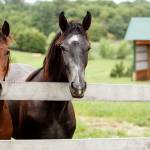Feeding Young Horses in Confinement

Young horses end up in confinement for any number of reasons, though injuries caused by roughhousing and surgeries for conformational faults seem to head the list. Pasture playtime offers an appropriate release for the natural exuberance of young horses, but what is the best way to nourish weanlings and yearlings when they are kept in stalls, sometimes for long periods of time?
“Requirements for protein, minerals, and vitamins do not change in young horses with exercise restrictions,” said Kathleen Crandell, Ph.D., a nutritionist with Kentucky Equine Research (KER). “However, owners might think twice about how best to deliver those nutrients, especially in high-strung weanlings or yearlings. Sometimes the usual way isn’t the best way.”
As with all equine diets, forage is the primary consideration. A legume-based forage, such as an alfalfa (lucerne) or alfalfa-mix, is still a sound choice for growing horses, even if they are confined to a stall, but it typically packs more calories than grass hay. A choice-quality grass hay will do just as nicely in this situation, according to Crandell. “Considering more grass hay can be fed for calorie equivalency, this might be a preferable strategy, specifically if an owner is trying to limit boredom. More time chewing hay is always preferable to wood-chewing or development of another vice.”
Young horses will likely also be fed a fortified feed that supplies them with protein, vitamins, and minerals not found in forage. Some young horses do well on the amount of fortified feed recommended by the manufacturer and will not show any sign of pent-up energy. Others, however, will not handle the energy overload well, and for these horses, an alternate diet should be developed. Such a diet will also work on weanlings and yearlings that begin to gain weight on stall rest, as well as for those that might show signs of physitis or other developmental problems.
“One of the easiest ways to supply young horses with all of the nutrients required for growth, including the essential amino acid lysine, without excessive calories is through the use of a ration balancer,” said Crandell. “The nutrition in a ration balancer is concentrated, so very little is fed in comparison to a traditional textured or pelleted feed. Although recommendations differ from manufacturer to manufacturer, a young horse might only require 1-2 lb (0.5-1 kg) of a ration balancer.”
Depending on the individual horse, this is not an either-or proposition—young horses don’t have to be on fed one product or the other. Many young horses in confinement do exceedingly well on diets that contain some traditional feed and a measure of ration balancer. Consultation with an equine nutritionist to help determine what’s best for a particular young horse.
One oft-neglected consideration of confinement involves bone health. Periods of confinement cause bone demineralization in young horses, even if the diet is nutritionally sound. To counteract this, young horses should be offered Triacton, a triple-action supplement designed to improve bone density and to support digestive health by providing a buffer to the stomach and hindgut. Triacton is especially useful in confinement situations as gastric ulcers often occur with management strategies that do not involve periods of grazing.
As an alternative to Triacton, horse owners can look to DuraPlex, a proprietary blend of specific proteins, vitamins, and minerals scientifically proven to reduce bone demineralization and increase bone mineral density. Studies conducted at KER have shown positive changes in bone quality after just one month of supplementation.








